#beetroot salad recipe
Explore tagged Tumblr posts
Text
Pomegranate and Beetroot Salad (Vegan)
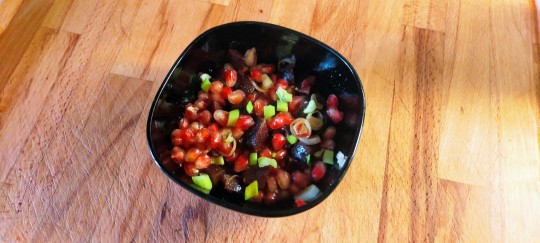
This bright Pomegranate and Beetroot Salad is a bowl of delightful freshness, on one of these warmer late Autumn days, especially if you've dug up half of the ingredients in your Kitchen Garden this very morning! Happy Monday!
Ingredients (serves 1):
a small Garden Beetroot (boiled a couple of hours or so until tender, and completely cooled)
half a large pomegranate
a small Green Onion
a pinch of fleur de sel or sea salt flakes and freshly cracked black pepper
1/2 tablespoon olive oil
1/2 tablespoon Modena Balsamic Vinegat
Peel Beetroot, and, using a sharp knife, cut them into dices. Spoon Beetroot dices in a small bowl.
Release the seeds from the pomegranate halve into the bowl.
Thinly slice Green Onion, and add to the bowl.
Season with fleur de sel and black pepper. Drizzle with olive oil and Balsamic Vinegar. Toss gently until well-combined.
Enjoy Pomegranate and Beetroot Salad immediately or chill in the refrigerator until serving time.
#Recipe#Food#Pomegranate and Beetroot Salad#Pomegranate and Beetroot Salad recipe#Beetroot Salad#Beetroot Salad recipe#Beetroot#Garden Beetroot#Gardening and Growing#Garden Vegetables#Green Onion#Garden Green Onion#Pomegranate#Pomegranate Seeds#Fresh Pomegranate#Fleur de Sel#Black Pepper#Black Peppercorns#Olive Oil#Balsamic Vinegar#Modena Balsamic Vinegar#Salad#Salad recipe#Salad and Side#Vegan Salad#Vegan#Vegan recipe#Vegetarian and Vegan#Meatless Monday#Quick recipe
1 note
·
View note
Text

Crumbed fish with homemade sweet potato chips and beetroot salad 🥗 🍠
#crumbed fish#fish#pescatarian#sweet potatoes#sweet potato#salad recipes#salad#beetroot#healthy#health#food#inspiration#nutrition#nutrients#cooking#positivity#dinner#weight loss#foodspo#meal ideas#lunch#meal inspiration#protein#quotes#healthy food#healthy diet#healthy eating#meals#meal inspo#lazy meal
11 notes
·
View notes
Text
hello to all the finns who got lured in by my april fools game <3 🇫🇮
#now i reveal this was all just a scheme to find someone who would share with me your christmas beetroot salad recipe#or the perfect glögi proportions#(ik i can google it)#(last time i went to pikkujoulu and asked abt the salad jukka shrugged and went IDK ITS PINK..... THERES PROBABLY SOME BEETROOT IN THERE...)#or send me a packige with cloudberry jam
35 notes
·
View notes
Text
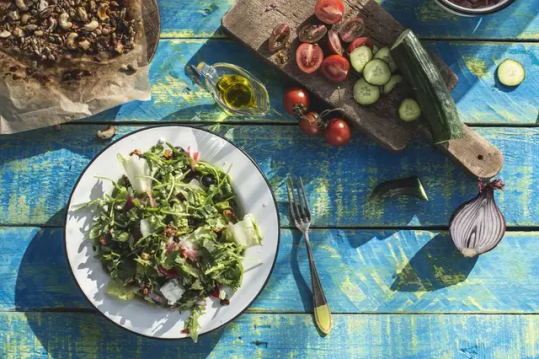
Don't mind me, just saving some salad recipes I heard on NPR
Vidal's salad aka Jay's dad (serves four people)
Ingredients: 1 pound of green beans, 3/4 pounds of tomatoes, 1 hard-boiled egg, pinch of salt, and splash of fish sauce.
Blanche the green beans: Cook them in boiling salted water for about three to five minutes (until they are cooked so they have a little give when you bite them). They should be sweet and bright green.
Put green beans in cold water to stop them from cooking.
Slice the tomatoes any way you want.
Add tomatoes to green beans.
Option to add a hard-boiled egg on top as well.
Season with salt and add a little drizzle of fish sauce.
Annette Sacksteder's bowl of life salad (makes about four days worth of salad)
Clean and assemble:
2 heads of lettuce such as romaine
1 bunch of spinach
1/2 bunch of rainbow chard (raw is ok)
1/3 bunch of cilantro
1/3 bunch of parsley
6 radishes including their greens
1 grated carrot
1 grated beet
1 cup of red or green cabbage
#recipes to try#bowl of life salad#green bean salad#green beans#tomatoes#egg#fish sauce#lettuce#spinach#chard#cilantro#parsley#radishes#carrot#beetroot#cabbage
10 notes
·
View notes
Text
#crab xec xec#bhatt ki churkani#bhatt ki churkani recipe#bhat ki churkani#Singju Salad Recipe#kothamalli sadam#chainsoo recipe#Singju Salad#Kozhi Ishtu#Beetroot Kanji Recipe#Beetroot Kanji#Dalma Recipe#goan fish curry recipe#goan crab curry#mutton rogan josh kashmiri recipe#manipuri singju#best indian recipes#North Indian food#pav bhaji recipe in English
0 notes
Text
Fresh and Festive: Christmas-Inspired Salads
Christmas isn’t just about rich roasts and decadent desserts; it’s also the perfect time to showcase bright, fresh, and healthy salads (particularly down-under!). Adding festive red and green touches to your table can balance the heavier dishes and create a stunning visual feast. Here are a few Christmas-inspired salad ideas, including one your children would surely approve of! 1. Watermelon and…
#beetroot salad#christmas ideas#christmas inspiration#christmas lunch#christmas recipes#eat clean#fruit salad#fruit salads#healthy recipes#holiday recipes#kale salad#mango salad#salads#summer salads#watermelon salad
0 notes
Link
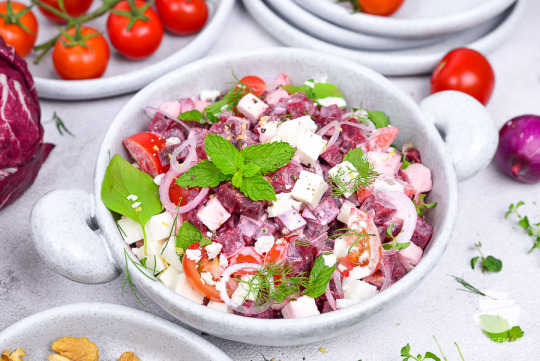
Unser einfacher Salat begeistert farblich wie auch geschmacklich durch rote Beete, frische Tomaten und viel würzigem Feta. Mit einem leichten Sahnedressing und aromatischen Kräutern entsteht in nur 10 Minuten eine raffinierte Vorspeise oder (Grill) Beilage.
#vorspeise#salat#gesund#rote beete#rote bete#beetroot#salad#rezept#recipe#beilagensalat#beilage#gesundes rezept#schnelle rezepte#abendessen#mittagessen#selbstgemacht#waskocheich#schnelles rezept#foodblog#foodblogger#foodpics#foodporn
1 note
·
View note
Text
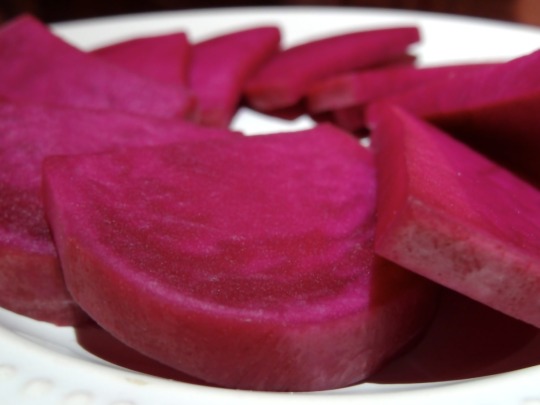
[ID: A circle of overlapping semi-circular bright pink pickles arranged on a plate, viewed from a low angle. End ID]
مخلل اللفت / Mukhallal al-lifit (Pickled turnips)
The word "مُخَلَّل" ("mukhallal") is derived from the verb "خَلَّلَ" ("khallala"), meaning "to preserve in vinegar." "Lifit" (with diacritics, Levantine pronunciation: "لِفِتْ"), "turnip," comes from the root "ل ف ت", which produces words relating to being crooked, turning aside, and twisting (such as "لَفَتَ" "lafata," "to twist, to wring"). This root was being used to produce a word meaning "turnip" ("لِفْتْ" "lift") by the 1000s AD, perhaps because turnips must be twisted or wrung out of the ground.
Pickling as a method of preserving produce so that it can be eaten out of season is of ancient origin. In the modern-day Levant, pickles (called "طَرَاشِيّ" "ṭarāshiyy"; singular "طُرْشِيّ" "ṭurshiyy") make up an important culinary category: peppers, carrot, olives, eggplant, cucumber, cabbage, cauliflower, and lemons are preserved with vinegar or brine for later consumption.
Pickled turnips are perhaps the most commonly consumed pickles in the Levant. They are traditionally prepared during the turnip harvest in the winter; in the early spring, once they have finished their slow fermentation, they may be added to appetizer spreads, served as a side with breakfast, lunch, or dinner, eaten on their own as a snack, or used to add pungency to salads, sandwiches, and wraps (such as shawarma or falafel). Tarashiyy are especially popular among Muslim Palestinians during the holy month of رَمَضَان (Ramaḍān), when they are considered a must-have on the إِفْطَار ("ʔifṭār"; fast-breaking meal) table. Pickle vendors and factories will often hire additional workers in the time leading up to Ramadan in order to keep up with increased demand.
In its simplest instantiation, mukhallal al-lifit combines turnips, beetroot (for color), water, salt, and time: a process of anaerobic lacto-fermentation produces a deep transformation in flavor and a sour, earthy, tender-crisp pickle. Some recipes instead pickle the turnips in vinegar, which produces a sharp, acidic taste. A pink dye (صِبْغَة مُخَلَّل زَهْرِي; "ṣibgha mukhallal zahri") may be added to improve the color. Palestinian recipes in particular sometimes call for garlic and green chili peppers. This recipe is for a "slow pickle" made with brine: thick slices of turnip are fermented at room temperature for about three weeks to produce a tangy, slightly bitter pickle with astringency and zest reminiscent of horseradish.
Turnips are a widely cultivated crop in Palestine, but, though they make a very popular pickle, they are seldom consumed fresh. One Palestinian dish, mostly prepared in Hebron, that does not call for their fermentation is مُحَشّي لِفِتْ ("muḥashshi lifit")—turnips that are cored, fried, and stuffed with a filling made from ground meat, rice, tomato, and sumac or tamarind. In Nablus, tahina and lemon juice may be added to the meat and rice. A similar dish exists in Jordan.
Turnips produced in the West Bank are typically planted in open fields (as opposed to in or under structures such as plastic tunnels) in November and harvested in February, making them a fall/winter crop. Because most of them are irrigated (rather than rain-fed), their yield is severely limited by the Israeli military's siphoning off of water from Palestine's natural aquifers to settlers and their farms.
Israeli military order 92, issued on August 15th, 1967 (just two months after the order by which Israel had claimed full military, legislative, executive, and judicial control of the West Bank on June 7th), placed all authority over water resources in the hands of an Israeli official. Military order 158, issued on November 19th of the same year, declared that no one could establish, own, or administer any water extraction or processing construction (such as wells, water purification plants, or rainwater collecting cisterns) without a new permit. Water infrastructure could be searched for, confiscated, or destroyed at will of the Israeli military. This order de facto forbid Palestinians from owning or constructing any new water infrastructure, since anyone could be denied a permit without reason; to date, no West Bank Palestinian has ever been granted a permit to construct a well to collect water from an aquifer.
Nearly 30 years later, the Interim Agreement on the West Bank and the Gaza Strip (also called the Oslo II Accord or the Taba Agreement), signed by Israel and the Palestine Liberation Organization (PLO) in 1995, officially granted Israel the full control over water resources in occupied Palestine that it had earlier claimed. The Argreement divided the West Bank into regions of three types—A, B, and C—with Israel given control of Area C, and the Palestinian Authority (PA) supposedly having full administrative power over Area A (about 3% of the West Bank at the time).
In fact, per article 40 of Annex 3, the PA was only allowed to administer water distribution in Area A, so long as their water usage did not exceed what had been allocated to them in the 1993 Oslo Accord, a mere 15% of the total water supply: they had no administrative control over water resources, all of which were owned and administered by Israel. This interim agreement was to be returned to in permanent status negotiations which never occurred.
The cumulative effect of these resolutions is that Palestinians have no independent access to water: they are forbidden to collect water from underground aquifers, the Jordan River, freshwater springs, or rainfall. They are, by law and by design, fully reliant on Israel's grid, which distributes water very unevenly; a 2023 report estimated that Israeli settlers (in "Israel" and in the occupied West Bank) used 3 times as much water as Palestinians. Oslo II estimations of Palestinians' water needs were set at a static number of million cubic meters (mcm), rather than an amount of water per person, and this number has been adhered to despite subsequent growth in the Palestinian population.
Palestinians who are connected to the Israeli grid may open their taps only to find them dry (for as long as a month at a time, in بَيْت لَحْم "bayt laḥm"; Bethlehem, and الخَلِيل "al-khalīl"; Hebron). Families rush to complete chores that require water the moment they discover the taps are running. Those in rural areas rely on cisterns and wells that they are forbidden to deepen; new wells and reservoirs that they build are demolished in the hundreds by the Israeli military. Water deficits must be made up by paying steep prices for additional tankards of water, both through clandestine networks and from Israel itself. As climate change makes summers hotter and longer, the crisis worsens.
By contrast, Israeli settlers use water at will. Israel, as the sole authority over water resources, has the power to transfer water between aquifers; in practice, it uses this authority to divert water from the Jordan River basin, subterranean aquifers, and بُحَيْرَة طَبَرِيَّا ("buḥayrat ṭabariyyā"; Lake Tiberias) into its national water carrier (built in 1964), and from there to other regions, including the Negev Desert (south of the West Bank) and settlements within the West Bank.
Whenever Israel annexes new land, settlers there are rapidly given access to water; the PA, however, is forbidden to transport water from one area of the West Bank to another. Israel's control over water resources is an important part of the settler colonial project, as access to water greatly influences the desirability of land and the expected profit to be gained through its agricultural exports.
The result of the diversion of water is to increase the salinity of the Eastern Aquifer (in the West Bank, on the east bank of the Jordan River) and the remainder of the Jordan that flows into the West Bank, reducing the water's suitability for drinking and irrigation; in addition, natural springs and wells in Palestine have run dry. In this environment, water for drinking and watering crops and livestock is given priority, and many Palestinians struggle to access enough water to shower or wash clothing regularly. In extreme circumstances, crops may be left for dead, as Palestinian farmers instead seek out jobs tending Israeli fields.
Some areas in Palestine are worse off in this regard than others. Though water can be produced more easily in the قَلْقِيلية (Qalqilya), طُولْكَرْم (Tulkarm) and أَرِيحَا ("ʔarīḥā"; Jericho) Districts than in others, the PA is not permitted to transfer water from these areas to areas where water is scarcer, such as the Bethlehem and Al-Khalil Districts. In Al-Khalil, where almost a third of Palestinian acreage devoted to turnips is located [1], and where farming families such as the Jabars cultivate them for market, water usage averaged just 51 liters per person per day in 2020—compare this to the West Bank Palestinian average of 82.4 liters, the WHO recommended daily minimum of 100 liters, and the Israeli average of 247 liters per person per day.
As Israeli settlement גִּבְעַת חַרְסִינָה (Givat Harsina) encroached on Al-Khalil in 2001, with a subdivision being built over the bulldozed Jabar orchard, the Jabars reported settlers breaking their windows, destroying their garden, throwing rocks, and holding rallies on the road leading to their house. In 2010, with the growth of the קִרְיַת־אַרְבַּע (Kiryat Arba) settlement (officially the parent settlement of Givat Harsina), the Jabars' entire irrigation system was repeatedly torn out, with the justification that they were stealing water from the Israeli water authority; the destruction continued into 2014. Efforts at connecting and expanding Israeli settlements in the Bethlehem area continue to this day.
Thus we can see that water deprivation is one tool among many used to drive Palestinians from their land; and that it is connected to a strategy of rendering agriculture impossible or unprofitable for them, forcing them into a state of dependence on the Israeli economy.
Turnips, as well as cabbage and chili peppers, are also grown in the village of وَادِي فُوقِين (Wadi Fuqin), west of Bethlehem. In 2014, Israel annexed about 1,250 acres of land in Wadi Fuqin, or a third of the village's land, "effectively [ruling] out development of the village and its use of this land for agriculture." Most of this land lies immediately to the west of a group of settlements Israel calls גּוּשׁ עֶצְיוֹן ("Gush Etzion"; Etzion Bloc). Building here would link several non-contiguous Israeli settlements with each other and with القدس (Al-Quds; "Jerusalem"), hemming Palestinians of the region in on all sides (many main roads through Israeli settlements cannot be used by anyone with a Palestinian ID). [2] PLO executive committee member Hanan Ashrawi said that the annexation, which was carried out "[u]nder the cover of [Israel's] latest campaign of aggression in Gaza," "represent[ed] Israel’s deliberate intent to wipe out any Palestinian presence on the land".
This, of course, was not the beginning of this strategy: untreated sewage from Gush Etzion settlements had been contaminating crops, springs, and groundwater in Wadi Fuqin since 2006, which also saw nearly 100 acres of Palestinian land annexed to allow for expansion of the Etzion Bloc.
All of this has obviously had an effect on Palestinian agriculture. A 1945–6 British survey of vegetable production in Palestine found that 992 dunums were devoted to Arab turnip production (954 irrigated and 38 rain-fed; no turnip production was attributed to Jewish settlers). A March 1948 UN report claimed that "[i]n most districts the markets are well-supplied with all the common winter vegetables—cabbages, cauliflowers, lettuce and spinach; carrots, turnips and and beets; beans and peas; green onions, eggplants, marrows and tomatoes." By 2009, however, the area given to turnips in Palestine had fallen to 918 dunums. Of these, 864 dunums were irrigated and 54 rain-fed. This represents an increase in unirrigated turnips (5.8%, up from 3.9%) that is perhaps related to difficulty in obtaining sufficient water.
Meanwhile, Israel profits from its restriction of Palestinian agriculture; it is the largest exporter of turnips in West Asia (I found no data for turnip exports from Palestine after 1922, suggesting that the produce is all for local consumption).
The pattern that Ashrawi called out in 2014 continued in 2023, as Israel's genocide in Gaza occurs alongside the continued and escalating killing and expulsion of West Bank Palestinians. The 2014 annexations, which represented the largest land grab for over 30 years and which appeared to institute a new era of state policy, have been followed up in subsequent years with more land claims and settlement-building.
Israeli military and settler raids and massacres in the West Bank, which had already killed 248 in 2023 before the حَمَاس (Hamas) October 7 offensive had taken place, accelerated after the attack, with forced expulsions of Palestinians (including Bedouin Arabs), and harassment, raids, kidnappings, and torture of Palestinians by a military armed with rifles, tanks, and drones. This violence has been opposed by armed resistance groups, who defend refugee camps from military raids with strategies including the use of improvised explosives.
Support Palestinian resistance by buying an e-sim for distribution in Gaza; donating to help two Gazans receive medical care; or donating to help a family leave Gaza.
[1] 918 dunums were devoted to turnips according to the Palestinian Central Bureau of Statistics (PCBS) report for 2009; the 2008 PCBS report attributes 253 dunums of turnip cultivation to Al-Khalil ("Hebron") for 2006–7.
[2] Today, Gush Etzion is connected to Al-Quds by an underground road that runs beneath the Palestinian Christian town of بَيتْ جَالَا (Bayt Jala).
Ingredients:
Makes 2 1-liter mason jars.
500g (4 medium) turnips
1 beetroot
1 medium green chili pepper (فلفل حار خضر��), halved
2 small cloves garlic, peeled
1 liter (4 cups) distilled or filtered water
25g coarse sea salt (or substitute an equivalent weight of any salt without iodine)
Some brining recipes for lifit call for the addition of a spoonful of sugar. This will increase the activity of lactic-acid-producing bacteria at the beginning of the fermentation, producing a quicker fermentation and a different, sourer flavor profile.
Instructions:
1. Clean two large mason jars thoroughly in hot water (there is no need to sterilize them).
2. Scrub vegetables thoroughly. Cut the top (root) and bottom off of each turnip. Cut each turnip in half (from root end to bottom), and then in 1 cm (1/2") slices (perpendicular to the last cut). Prepare the beetroot the same way.

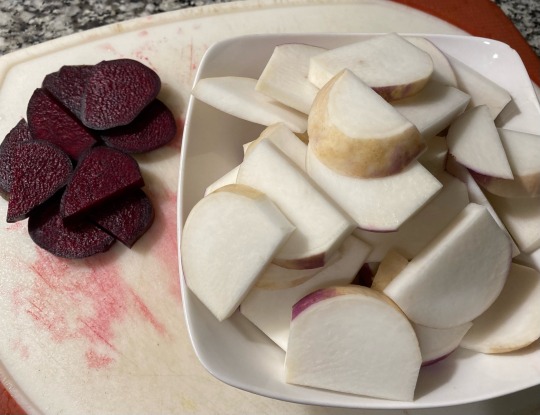
If you need your pickles to be finished sooner, cut the turnips into thinner slices, or into thick (1/2") baton shapes; these will need to be fermented for about a week.
3. Arrange turnip and beet slices so that they lie flat in your jars. Add garlic and peppers.
4. Whisk salt into water until dissolved and pour over the turnips until they are fully submerged. Seal with the jar's lid and leave in a cool place, or the refrigerator, for 20–24 days.
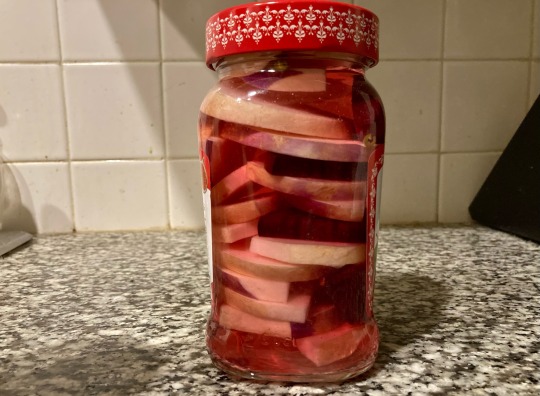
The amount of brine that you will need to cover the top of the vegetables will depend on the shape of your jar. If you add more water, make sure that you add more salt in the same ratio.
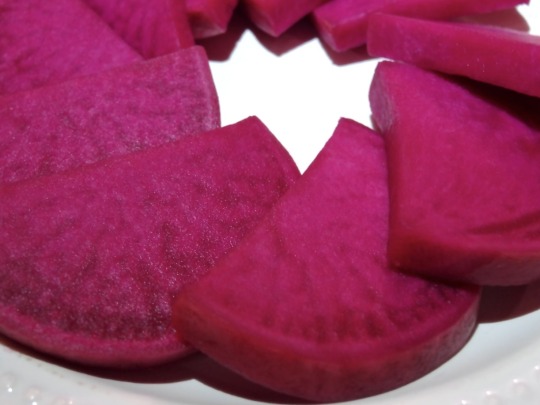
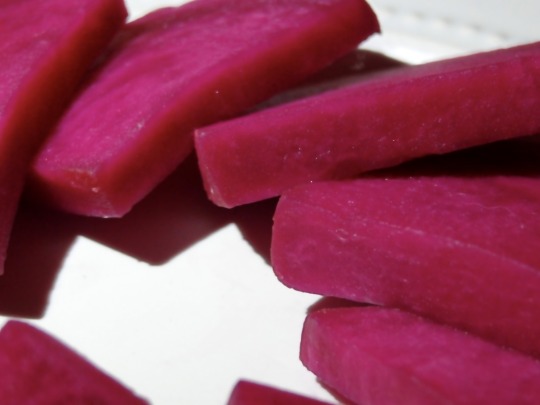
295 notes
·
View notes
Text


Recipe development and food styling by healgoblin of wild rice bowls for FKA Twigs and Jemma Mayo. Wild Alaskan salmon patty (top) or grilled tempeh (bottom); sauteed shiitake and oyster mushrooms; roasted beetroot, purple sweet potato, and carrots; avocado; wakame and cucumber salad; pickled ginger; and spinach, zucchini, and snow peas.
Source: x
13 notes
·
View notes
Text
Rainbow Salad (Vegan)
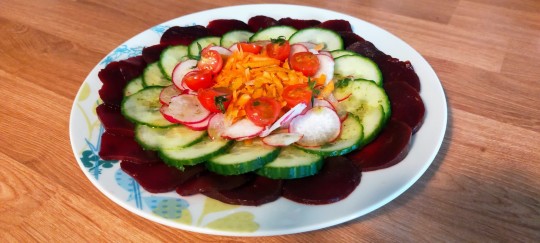
Colouful and flavourful, this Rainbow Salad makes a vibrant lunch, one best enjoyed in the garden, to make the most of the still warm days! Happy Friday!
Ingredients (serves 1):
2 small Garden Beetroots (boiled a couple of hours or so until tender, and completely cooled)
a quarter of a large cucumber, rinsed
3 large radishes, rinsed
1 large carrot
4 Garden Cherry Tomatoes
Peel Beetroots, and, using a sharp knife, cut them into thin slices.
Cut cucumber and radishes into thin slices, too.
Peel carrot and, using the coarse side of a box grater, grate it.
Halve Cherry Tomatoes.
Arrange Beetroot and cucumber slices into circles onto serving plate. Spoon grated carrot in the middle, and top with radish slices and Cherry Tomatoes.
Serve Rainbow Salad, drizzled generously with a fragrant dressing, like basil vinaigrette or Mint and Shallot Dressing.
#Recipe#Food#Rainbow Salad#Rainbow Salad recipe#Salad#Salad recipe#Salad and Side#Beetroots#Garden Beetroots#Cucumber#Radishes#Carrot#Cherry Tomatoes#Garden Cherry Tomatoes#Vegan Salad#Vegan recipe#Vegetarian annd Vegan#Quick recipe#Easy recipe
4 notes
·
View notes
Note
Hi! Thank you for the health advice! I would love to quit or significantly reduce carbs, I also feel like it's heavy on my body, but so many meals revolve around grains (sourdough bread mostly) and I guess there's a craving aspect to it too... Could you give advice on what you're eating instead?? I have lots of eggs, fish, occasional meat, plenty of fruit, just enough veg haha but i find it hard to imagine going without carbs (or grains more specifically cos I have no prob with vege carbs). Especially in winter 😋 Thank you for any help 🙏🙏
I feel like society has normalised feeling heavy and lethargic after meals, but its amazing you have noticed this and want to change!
You may want to cut carbs gradually (no starches - breads, grains, rice, pasta, potatoes).
I would recommend looking into GI index to see what foods are high glucose, following Hormone Balancing recipes, juices etc (usually very low carb and support women's health). Listening to podcasts on microbiome, or even a tiktok search.
Introducing pre/ probiotics: I make sauerkraut (which is basically cabbage / onions in water and salt left to ferment for a few days - lots of variations on this), also just made my first batch of Kefir (I stay away from store bought Kefir as its pasturised and all the good stuff has been killed off during this process). I mention these as a healthy gut is going to support you as you remove carbs and introduce more wholesome foods.
Breakfasts:
Omlette (spinach / onion / parsley )
Scrambled eggs w/ coconut oil
Buckwheat porridge w/ blueberries (buckwheat is a seed not a grain so low glucose index)
Avocado salad (seeds, olives, rocket, tomatoes, cucumber) +tahini
Snacks:
Nuts, olives, blueberries, blackberries, watermelon
Main meals:
Veg + Protein (Broccli, kale, butternut squash, courgette, carrots, asparagus, cabagge, peppers). I do different variations of veg to mix things up, sometimes i do Chinese style stir fry, I try to add garlic and ginger as much as possible into the veg. Protein is usually grass fed steak, whole fish - seabream, sea bass, mackerel, cod fillet, wild salmon fillet, or turkey breast fillet. I make chimichurri sauce to add some extra flavour to the fish.
Protein + lentil / chicpeas dish. I have a stew a few days a week to break up the veggies because they do get boring after a while.
Bone broth. I boil the bones, and have as a little side dish with veggies but this isn't really filling enough for a main meal.
I make beetroot juice, and also watermelon juice, tumeric + ginger shots throughout the week. I try to throw in flaxseed and chia seeds where possible.
I cut coffee/ decaf all that and now only drinking fresh mint tea, slice of lemon + hot water, fresh juices (within the hour of making), and water ensuring 2l per day.
Number one thing that had to go was oats. So if you are having a morning crash I suggest cutting the carbs first thing. I know there are suggestions (glucose goddess) that fat with carbs or when you eat them (having carbs after veg can help) but personally i think its best to cut them.
I hope this helps! Its a full lifestyle change that has honestly helped so much! It's a commitments, but investing in feeling good and your health will make you feel so good and wholesome! xoxoxo
*I used the free 1 month trial of MyFitnessPal app to track my calories/ meals to ensure I was getting enough food - for some this might be extreme but super helpful to see what’s going on.
#levelupjourney#manifestyourreality#levelup#lawofattraction#manifesting#growthmindset#healthy body#healthyfood#healthy diet#keto diet#gutmicrobiome
45 notes
·
View notes
Text
instagram recipe: welcome back to my series Situationship Salads. salads that are free from toxic ingredients unlike your situationship who just ghosted you for the fourth time . trust me, this salad is so good you’ll want to go back to it over and over again, just like your situationship,
the comments: yessss girl 🙌 beetroots are my new hyperfixation food so you better believe i’m gonna be making this for brunch !!
pinterest recipe: 1 ingredient air fryer banana bread. no flour no gluten no sugar because it’s literally just a banana thats been air fried for 3 hours
comments: can i make this with no banana 🍌’s , and no air fryer , ❓
7 notes
·
View notes
Note
You and anya should make a meal together soon! I wonder what you'd make.
We’re going to! I’ve been practicing the recipes from Anya’s mother. :-) I made this salad a couple days ago, it’s called a vinaigrette but not like…not the kind we know, it’s genuinely just a salad. Beetroot (of course), cooked carrots, salty cucumbers, peas…potatoes…something else… Oh, and so much mayo.
Once Anya deems my endeavours worthy, we’re going to have a proper Russian dinner. I’m looking forward to it.
It…makes me feel some kind of way, getting to make what her mother used to make. I wonder what she would make of my attempts. I hope she would like that.
13 notes
·
View notes
Text

EVANGELITE SLAVE CUISINE
(This article was actually a request from a long time ago. I don't even remember who requested it, but thank you for the idea!)
OVERVIEW
Slavery is the backbone of Evangeline Kingdom’s economy. Without all this unpaid labor, the entire kingdom would crumble, and a big chunk of the world’s food supply would go down with it. Evangelite slaves literally work themselves to death putting food on everyone’s tables but their own, as their masters are often cheap and refuse to feed them properly. These slaves have found crafty ways to supplement their nutrition themselves.
GRUEL
Colloquially known as “slave slop”, gruel is the staple food of Evangelite slaves, which is provided in rations by their masters. This dish is simply a cereal–such as oats or rice–boiled in milk. If the master is especially stingy, the milk is substituted for water. It’s typical for slaves to eat this for every meal. Slave owners choose gruel as their main staple because of its cheap price, but it is lacking in nutrition, so vegetables and chunks of meat may be added on occasion to perk up sickly-looking slaves.
Gruel is not willingly eaten by Evangelite citizens. It is considered exclusively a “slave food”. Only prisoners and those in extremely destitute conditions will resort to eating this bland dish.
BLOODBREAD
This grisly recipe originated in Kelvingyard, the largest slave market on Looming Gaia. Kelvingyard slaves are deliberately underfed so that they will compete for food, leaving only the fittest slaves to survive. This filters out the weak and undesirable slaves without any effort on behalf of staff, leaving them free to do other things. Desperation has driven these slaves to invent bloodbread.
First, a crude flour is formed from crushed weeds, dirt, insects, blood, and bonemeal. The blood and bones may come from vermin or are sometimes harvested from dead slaves before staff comes to collect their bodies. The flour is shaped into biscuits and left out in the sun to “bake”. They must be fiercely guarded from other slaves while they’re baking, so it’s not uncommon for them to be eaten raw.
COURTYARD SALAD
There are two types of slaves in Evangeline Kingdom: Field slaves and house slaves. Field slaves are those which exclusively work outside, and are responsible for chores like crop tending and yard maintenance. This always includes weed-pulling, so slaves pocket all the edible weeds they can throughout the day and make a salad out of them later. Their masters usually prohibit them from taking home crops, but occasionally they find substantial gifts from nature such as wild beetroots, blackberries, and sunchokes encroaching on the crop fields.
The name “courtyard salad” originated from field slaves who tended courtyards of Evangelite nobles. These massive expanses of grass and manicured hedges were a testament to the nobles’ wealth, but they required hours of maintenance each day to keep them looking neat. The slaves who tend these courtyards can reap a large bounty of weeds for themselves during peak growing seasons.
COURTYARD TEA
Courtyard tea was developed under the same conditions as courtyard salad; field slaves pulling weeds from their masters’ gardens and making meals of them. But they didn’t just eat them, they drank them as well. Some weeds, such as dandelion and mint, make healthy, flavorful teas. These teas can also offer health benefits, which is particularly useful to slaves because they receive substandard medical care or none at all.
Evangelite slaves have passed on their knowledge of medicinal herbs to each other for generations. They use mint tea for digestive ailments, willow tea for pain relief, and chamomile tea for soothing anxiety, but those are just a few of the many possible effects these brews can have.
CASTAWAY STEW
Some slave owners do not allow their slaves to eat their table scraps, instead preferring to compost them for their gardens or feed them to their pets. The most miserly of them prefer to keep all but the rotten scraps as leftovers for their own families. But the wealthier ones tend to be more generous with their leftovers and allow their slaves to eat them.
Sometimes these scraps are eaten as-is, but they can also be thrown into a stew to stretch them further. House slaves are responsible for cleaning kitchens, so they typically reap the most benefit. But occasionally they will share their bounty with field slaves, or field slaves will pilfer these scraps themselves from their master’s trash bins. Cooking it in a stew helps to hide unpleasant flavors of any scraps that have begun to rot.
CRUUSTI
Much like castaway stew, cruusti is made from the leftovers that slaves collect from their masters’ dinner tables. However, cruusti is not a stew, it is a bread made from random crumbs that have been swept off counters, as well as bread crusts that the master’s children refused to eat. Crumbs can also be scraped off of baking pans and utensils. Slaves gather these small scraps of dry bread over time, then when they have enough, they rehydrate them in water and make a crude dough. Sometimes they get lucky and a stray chocolate chip or nut makes its way into the mix.
BONE SCRAPS
Cereal-based gruel is not sufficient enough to feed heavyweight slaves such as centaurs and minotaurs long-term, so their diets are supplemented with so-called “bone scraps”. These are the discarded animal bones from butcheries or dinner tables. They are given to slaves raw and they are often eaten raw too, but if slaves have the means, they may boil or bury them to make them softer. The marrow inside is nutritious and the bones themselves become jelly-like with proper cooking. Satyrs, centaurs, and minotaurs have strong jaws that can crush up the bones as-is, but other peoples struggle with this.
BEETROOT SOUP
Beetroot soup is the most famous dish eaten by Evangelite slaves. You can read about it on the main Evangelite Cuisine article.
*
Questions/Comments?
Lore Masterpost
Read the Series
10 notes
·
View notes
Text
#crab xec xec recipe#crab xec xec#bhatt ki churkani#bhatt ki churkani recipe#bhat ki churkani#Singju Salad Recipe#kothamalli sadam#chainsoo recipe#Singju Salad#Kozhi Ishtu#Beetroot Kanji Recipe#Beetroot Kanji#Dalma Recipe#goan fish curry recipe#goan crab curry#mutton rogan josh kashmiri recipe
0 notes
Note
Heyy there cutiee <3

If you eat only one thing for your entire life, what would it be? 👀
Hmmm, I would've said salads (and use the "everything chopped up is salad" argument) but that's basic and I'm NOT BASIC.
So I choose pasta/noodles !!! (I know "thats so unhealthy!!" But do i care? NAH)
I literally have a whole list of various different recipes and im sure I'd neveerrrr get bored of it like there's :
Tomato sauce
Mac n cheese
Garlic sauce
Caramelized onion sauce
Spinach sauce
Beetroot sauce
Cauliflower sauce
Split pea sauce
Toppings: Olives, Mushrooms, Tofu, Paneer, Egg, Potato, Chicken + much moorrreeeee!!!
(Yes, I'm very passionate about this so what)
(Also yes these are all tried and tested and all are my favs)
Thanks for the ask Bbg ♡♡♡!!!
6 notes
·
View notes